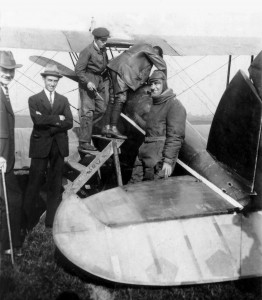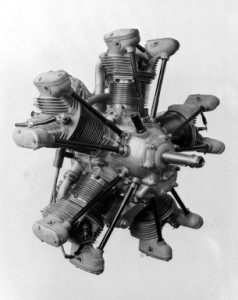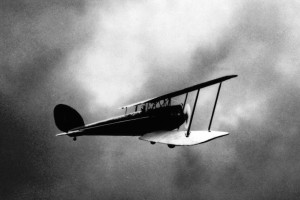In June of 1919 a BMW engine powering a Deutsche Flugzeugwerke F 37/III climbed to 9,760 meters or a little more than 32,000 feet, setting the company’s first world record, according to BMW.
The pilot, one Franz Zeno Diemer took off from Munich’s Oberwiesenfeld airfield and put his fate in the trust of a BMW IV airplane engine. Based on the existing BMW IIIa, the IV engine had its bore and stroke increased by 10 mm to boost output from 185 horsepower to 230.
On the Sunday he set the record, the weather was fair. It took Diemer 87 minutes to reach the record-setting height, for an average climb of 368 feet per minute, a rate that some light aircraft today can’t sustain on in hot weather after only a couple of thousand feet.
After the flight Diemer claimed that the engine still had the ability to climb, but that he himself had reached the limits of his capacity.
No kidding.
In his open pilot’s seat he experienced temperatures as low as -50° Celsius, but also the low oxygen levels in the air altitude, which took their toll on him physically. He was lucky he didn’t suffer from hypoxia and didn’t pass out. In fact, some skeptics say that without supplemental oxygen, it wouldn’t have been possible for him to remain conscious at that height.

Franz Zeno Diemer took off from Munich's Oberwiesenfeld airfield and put his fate in the trust of a BMW IV airplane engine.
The challenge Diemer faced was caused by the same underlying problem that all engines have struggled with since their invention, the loss of power at altitude. Normally an airplane produces its maximum output on the ground, which allows it to get enough airflow over the wings and control surfaces to produce lift and allow it to take off. But, as always, military needs pushed development into new areas, and the ability to out climb an enemy was one of the keys to survival that emerged during the War to end all Wars.
Since air density steadily decreases with altitude, unless you have a way of forcing more air into an engine than ambient pressure, power diminishes as well. Two different approaches were and still are pursued in an attempt to counteract the loss of output in the thinning air. Some manufacturers, such as rival Daimler, turned their attention to supercharging, whereby air was forced into the carburetor by means of a compressor. But this technology complex and only established itself in the 1930s. Friz opted for an “over-square” high-compression engine for the first BMW aircraft engine, the forerunner of the IV world record engine.
So BMW’s head designer Max Friz took the other route – there’s no substitute for cubic inches or liters as any American hot rodder will tell you. Friz opted for an “over-square” (bore greater than stroke) high-compression engine for the first BMW aircraft engine, the forerunner of the IV world record engine. This involved an enlargement of the cylinder volume as well as an increased compression ratio. To avoid engine overload and destructive pressures, it had to be throttled back at take-off and low flying altitudes.
To meet the demands of a high-altitude engine, Friz also designed a special carburetor to supply ensure a consistent air/fuel mixture ratio. The carburetor was controlled by two levers, one for normal operation and one for higher altitudes. By means of these two levers, the pilot could control the throttle valves of the carburetor in such a way that the optimum mix was prepared to suit the aircraft’s altitude at any time. The throttle valves were only opened fully once an altitude of 3,500 to 4,000 meters had been reached. This configuration meant that the loss of power of the IIIa at altitude was less than in other engines.
One of the first advocates of this concept was veteran Franz Zeno Diemer, an experienced flyer who earned his pilot’s license in 1913. During the First World War he served as a test pilot in the Bavarian Flying Corps. It was in this role that he came into contact with BMW in 1917 when testing the BMW IIIa aero engine. His flight in the summer of 1919 won international acclaim, even though it was denied official recognition.
All aviation records had to be confirmed by the Fédération Aéronautique Internationale (FAI) in order to be ratified. Although Germany was a founding member, it was excluded from the FAI as a result of the First World War. That is why Diemer’s flight never entered the official record lists. But even without a certificate, the ascent to almost 10,000 meters demonstrated the potential of the BMW aero engines.

Friz opted for an "over-square" (bore greater than stroke) high-compression engine for the first BMW aircraft engine, the forerunner of the IV engine.
At that time, the BMW engines were known for performance and their fuel economy as well. The first BMW IIIa had lightweight components in its design. Its crankcase and pistons were made of aluminum, giving a weight of just 285 kilograms and a weight-to-power ratio of 1.54 kg/hp. Diemer’s record-setting engine, IV, did better at 1.24 kg/hp.
During throttled operation, at 1,050 rpm, the BMW IIIa consumed 200 grams per hp hour, which was 33% better than other engine in this performance class. In practice it meant that, with a supply of around 200 kg of fuel – some 260 liters – an aircraft with the IIIa had an operating range of 1,200 kilometers, while the same amount of fuel in Brand X was good for only around 730 km.
Indeed, the BMW IIIa also had the edge over automobiles of the day. On one of his test flights, Diemer made it from Augsburg via Leipzig to Döberlitz in just under four hours, with the IIIa engine powering his aircraft using 84 liters of fuel. Over the same distance, a car at the time took 14 to 16 hours and consumed between 100 and 120 liters.



I have hanging on my wall a photo and on the fuelage is K4 along with the BMW logo D-2125. I have the original photos. I believe the name (Max Friz) is misspelled in this article only because the names on the tail are,
Max Furst
Max Seyffer
Munchen-Oberwiesenfeip
BMW’s head designer Max Friz is the person in the story, and that is how BMW spells his name in English.
You might have a photo of a different plane or a different version taken at another time.
The answer might be lost in the mists of time…